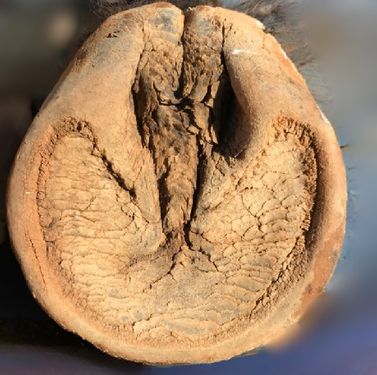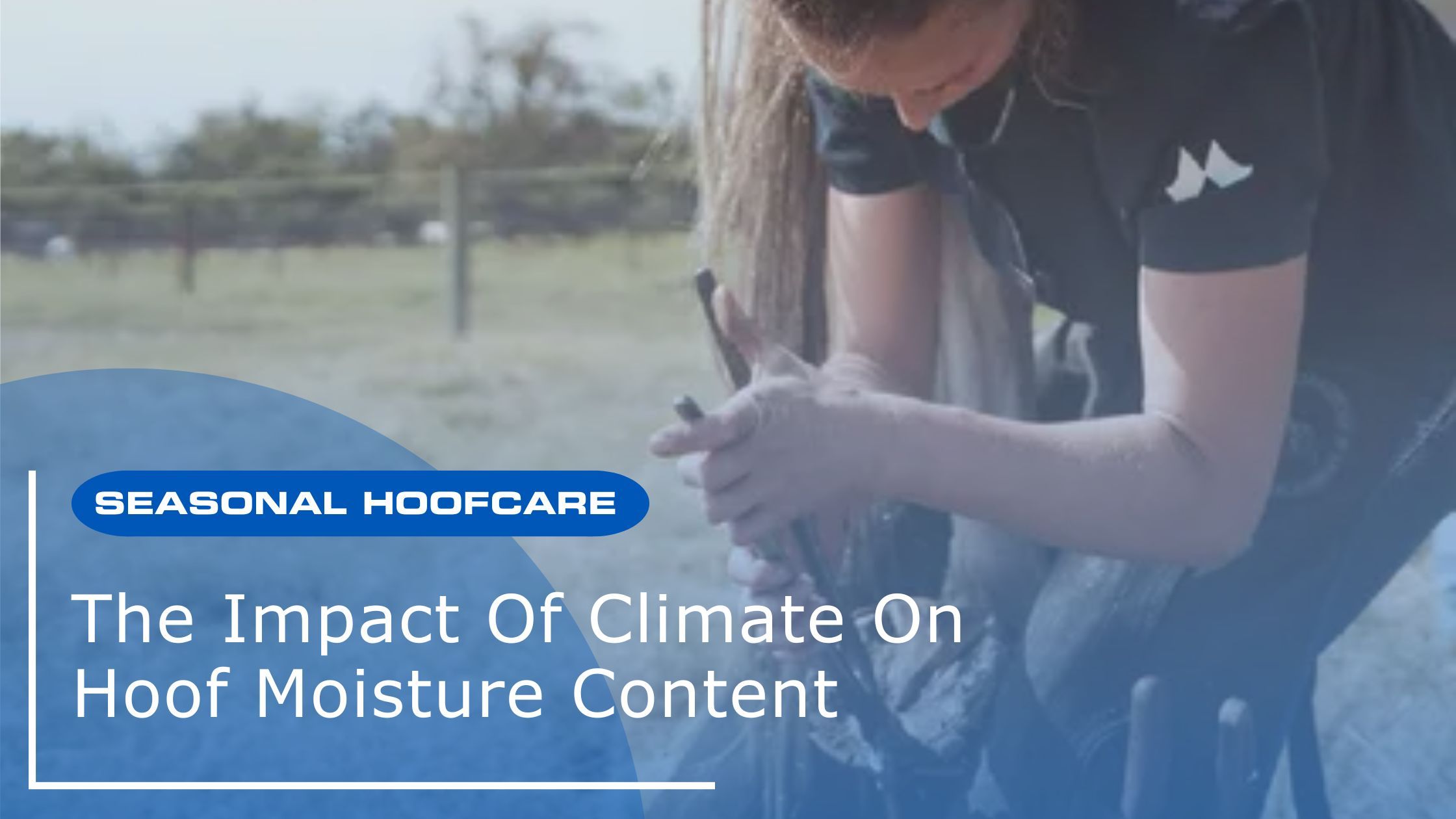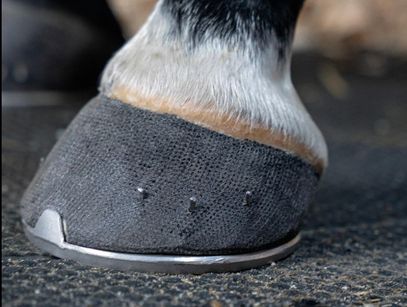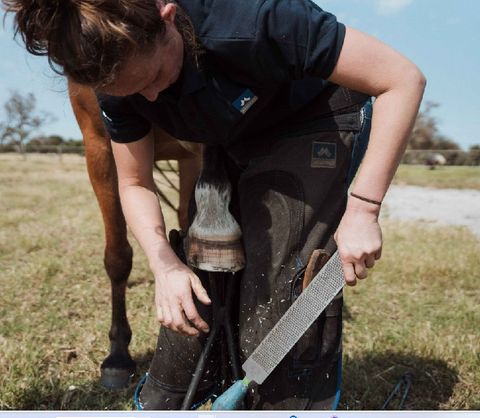The Impact of Climate On Hoof Moisture Content
The Impact Of Climate On Hoof Moisture Content
Hoof moisture content has a direct impact on hoof quality and function, so it is important to understand what influences it, and how best to combat these factors if their impact is negative. All factors interact to influence overall levels, however, there are certain standards that tend to be true across the board.
Most textbooks suggests that the average moisture content of the hoof is:
- Wall: 25% moisture content varies approx. 2% from coronary band to solar border
- Sole: 33%
- Frog: 50%
Studies also suggest that hind feet contain approx. 0.05% more moisture than front feet (Miyati,Et Al 1974) and that male horses have a slightly higher moisture content than female horses.
Factors That Can Influence Hoof Moisture Content
The balance of hoof moisture is drawn both from body fluids and the external environment, so it makes sense that it can be influenced not only by the horse’s hydration, but also the conditions they live in.
Another factor that influences moisture content is the age of the horse. Foals and younger horses will have a higher level rendering their hoof softer. As they grow older, this will decrease, and the hoof will become harder, therefore enabling the horse to deal with weight and the forces placed upon the hoof. This is why horse hoof maintenance is important.
Considerations Of The Australian Climate
Australia is the driest inhabited continent in the world. Seventy percent of Australia is either arid or semi-arid land, with rain fall averaging 250mm or less in arid zones, and between 200mm and 3000mm in semi-arid areas.
That being said, the majority of the population live on the fringes of the continent, as do many of the horses we service in our business. The climate in these fringe areas fluctuates significantly throughout the year, with rainfall varying from as much as 2000mm to as little as 300mm. As a result, we, as hoof care professionals, face a wide range of conditions, from hot and dry to wet, cold, or humid.
Climate impacts general care needs, as well as the application of horseshoes and materials, so we have to consider the effects that these conditions have on the horse’s hoof and the approach we take whilst maintaining it.
With this in mind, let us look at the individual conditions and their effect on the hoof.
Wet Conditions
The effect of wet conditions has been well documented, as much of the literature has been written by farriers working in these conditions. Although we know the average hoof moisture content, horses that are constantly exposed to wet, muddy, or unsanitary conditions can suffer from a variety of complaints as a direct influence of such conditions.
Hoof quality alone is a major concern, as the constant exposure to wet conditions in some cases diminishes the ability of the hoof to deal with the forces placed upon it. Both from the biomechanical aspect as well as the retention of horseshoes.
As mentioned earlier, the moisture content of the hoof wall decreases as it extends distally from the coronet to the solar border. Post-mortem studies of the hoof wall show that excessive moisture in the outer wall negatively impacts the stiffness of the horn tubules, resulting in a weaker structure that, in some cases, struggles to withstand the forces exerted on the hoof during movement.
This can result in hoof distortion or dropped soles, as well as difficulty retaining the shoe during shoeing cycles.
Additional conditions of the horse hoof health that may be directly associated with wet unsanitary conditions include:
- Thrush
- Fungal and Bacterial issues – e.g. White Line Disease and Seedy Toe
- Canker
- Hoof infections and/or abscesses
Hoof Care And Maintenance For Wet Conditions
Maintaining horses in such conditions involves minimising their exposure to wet, unsanitary environments whenever possible.
Shorter shoeing cycles may be a consideration as well as the use of additional clips, to reinforce the hoof and reduce nail impact upon the wall.
Hoof cast (see below) may be used, in an effort to support weak walls and assist with nailing, shoe retention and hoof stability.
In addition, there are a number of topical products to reduce the negative effect of moisture e.g. copper sulphate or Stockholm tar.
Humid Conditions
Similar to the effect of wet conditions, humid conditions predispose the horse to the increased risk of bacterial and fungal conditions.
The increased temperature associated with the humidity increases the probability of the proliferation of such bacterial or fungal conditions.
Hoof Care And Maintenance In Humid Areas
Diligent maintenance, including regular hoof cleaning and minimising the horse's exposure to these conditions wherever possible, is essential to reducing the risk of infection.
Similarly, the application of topical products to reduce the proliferation of bacterial or fungal infection may be employed. The use of products such as Comfort Mix Thrust Treatment or Hoof-it Hygiene, will help to prevent these conditions. Copper sulphate mixed with cider vinegar regularly applied to the sole with a toothbrush, is also a tried-and-true treatment.
Dry Conditions
Dry hoofs predominantly are easier to maintain from a farrier’s perspective. In Australia we tend to deal with this condition more often than not.
Although drier hoofs are more solid, dehydration can often lead to problems of its own. Some of which include:
- Cracks at the weakest part of the wall
- Disintegration of the wall thus reducing the surface contact with the shoe or the ground
- Reduced function/concussion absorption due to lack of moisture resulting in contraction
- Lack of concavity in the hoof
- Difficulty nailing shoes on due to the hard feet and nails bending
- Increased possibility of nails breaking during shoeing cycles
- Difficulty trimming the hoof as a result of being too hard to cut
- Increased wear on equipment such as nippers, rasps, knives etc
- Increased wear on your body as a result of the harder work involved

(Image: Dean Lewis 2018 - Dehydrated sole and frog of a wild horse on a Station in Central Australia)
Hot shoeing will assist the farrier when nailing on shoes by searing the hoof and achieving a flat surface. This also helps to soften the wall allowing easier nailing and hooves hydration.
Also choosing an adequate nail in dry conditions is important to me. I tend to stay away from thin shank nails in dry conditions, instead opting for a nail that reduces movement. In my practice I choose to use the Mustad concave range of nails, this in my opinion, reduces shoe loss and nail breakage.
Hoof Care And Maintenance In Dry Conditions
Application of topical treatments like hoof dressing such as oils in my experience is an effective method that helps to prevent the evaporation of moisture from the hoof. In my opinion, maintaining good hoof condition and adequate elasticity is crucial for sports and performance horses. Daily care becomes even more important when horses are dealing with conditions that impact their normal biomechanical function, such as hoof distortion, cracks, or side bone. I believe these issues can be aggravated by contraction resulting from dehydration.
I am of the opinion that application of these topical treatments prevents the dehydration of the hoof wall by reducing evaporation, rather than being the source of the hydration.
Adversely it has been my experience that the application of products like sump oil, hoof black and other products like Diesel have a caustic negative effect on the hoof.
Rehydrating Hooves And Balancing Hoof Moisture Content
In the past many farriers suggest that the owner stand the horse in water prior to a visit in an attempt to soften the hoofs.
A study published (Hampson, DeLaat, Mills, Pollit,2012) concluded that the soaking of horses front feet regularly would be unlikely to change the degree of hydration in the hoof wall horn, however it may further hydrate the sole.
I believe it’s important to note that most studies on hoof moisture content have been conducted on cadavers. In my opinion, this approach overlooks the normal functioning of the hoof, as it eliminates the role of blood flow and lymphatic fluid.
This may have a minimal effect on the internal hoof’s hydration mechanisms, however I don’t think this aspect of the biomechanical function of the hoof should be overlooked.
Conclusion
In conclusion maintaining a normal balance and trying to limit over exposure to extreme environments for extended lengths of time would seem the best approach, yet we all know this is not always possible.
As with most things with hoof care, regular shoeing intervals will give your hoof care professional the opportunity to address most issues before they become a problem, but there are many things that you as a horse owner can do to help your horse and your farrier achieve the best possible result.
I hope this blog has given some insight to this important aspect of hoof care.
All the Best Dean Lewis AWCF



